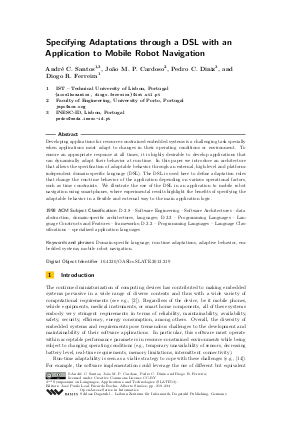Specifying Adaptations through a DSL with an Application to Mobile Robot Navigation
Authors André C. Santos, João M. P. Cardoso, Pedro C. Diniz, Diogo R. Ferreira
-
Part of:
Volume:
2nd Symposium on Languages, Applications and Technologies (SLATE 2013)
Part of: Series: Open Access Series in Informatics (OASIcs)
Part of: Conference: Symposium on Languages, Applications and Technologies (SLATE) - License:
 Creative Commons Attribution 3.0 Unported license
Creative Commons Attribution 3.0 Unported license
- Publication Date: 2013-06-05
File

PDF
OASIcs.SLATE.2013.219.pdf
- Filesize: 1.05 MB
- 16 pages
Document Identifiers
Subject Classification
Keywords
- Domain-specific language
- run-time adaptations
- adaptive behavior
- embedded systems
- mobile robot navigation
Metrics
- Access Statistics
-
Total Accesses (updated on a weekly basis)
0Document
0Metadata
Abstract
Developing applications for resource-constrained embedded systems is a challenging task specially when applications must adapt to changes in their operating conditions or environment. To ensure an appropriate response at all times, it is highly desirable to develop applications that can dynamically adapt their behavior at run-time. In this paper we introduce an architecture that allows the specification of adaptable behavior through an external, high-level and platform-independent domain-specific language (DSL). The DSL is used here to define adaptation rules that change the run-time behavior of the application depending on various operational factors, such as time constraints. We illustrate the use of the DSL in an application to mobile robot navigation using smartphones, where experimental results highlight the benefits of specifying the adaptable behavior in a flexible and external way to the main application logic.
Cite As Get BibTex
André C. Santos, João M. P. Cardoso, Pedro C. Diniz, and Diogo R. Ferreira. Specifying Adaptations through a DSL with an Application to Mobile Robot Navigation. In 2nd Symposium on Languages, Applications and Technologies. Open Access Series in Informatics (OASIcs), Volume 29, pp. 219-234, Schloss Dagstuhl – Leibniz-Zentrum für Informatik (2013)
https://doi.org/10.4230/OASIcs.SLATE.2013.219
BibTex
@InProceedings{santos_et_al:OASIcs.SLATE.2013.219,
author = {Santos, Andr\'{e} C. and Cardoso, Jo\~{a}o M. P. and Diniz, Pedro C. and Ferreira, Diogo R.},
title = {{Specifying Adaptations through a DSL with an Application to Mobile Robot Navigation}},
booktitle = {2nd Symposium on Languages, Applications and Technologies},
pages = {219--234},
series = {Open Access Series in Informatics (OASIcs)},
ISBN = {978-3-939897-52-1},
ISSN = {2190-6807},
year = {2013},
volume = {29},
editor = {Leal, Jos\'{e} Paulo and Rocha, Ricardo and Sim\~{o}es, Alberto},
publisher = {Schloss Dagstuhl -- Leibniz-Zentrum f{\"u}r Informatik},
address = {Dagstuhl, Germany},
URL = {https://drops.dagstuhl.de/entities/document/10.4230/OASIcs.SLATE.2013.219},
URN = {urn:nbn:de:0030-drops-40403},
doi = {10.4230/OASIcs.SLATE.2013.219},
annote = {Keywords: Domain-specific language, run-time adaptations, adaptive behavior, embedded systems, mobile robot navigation}
}
